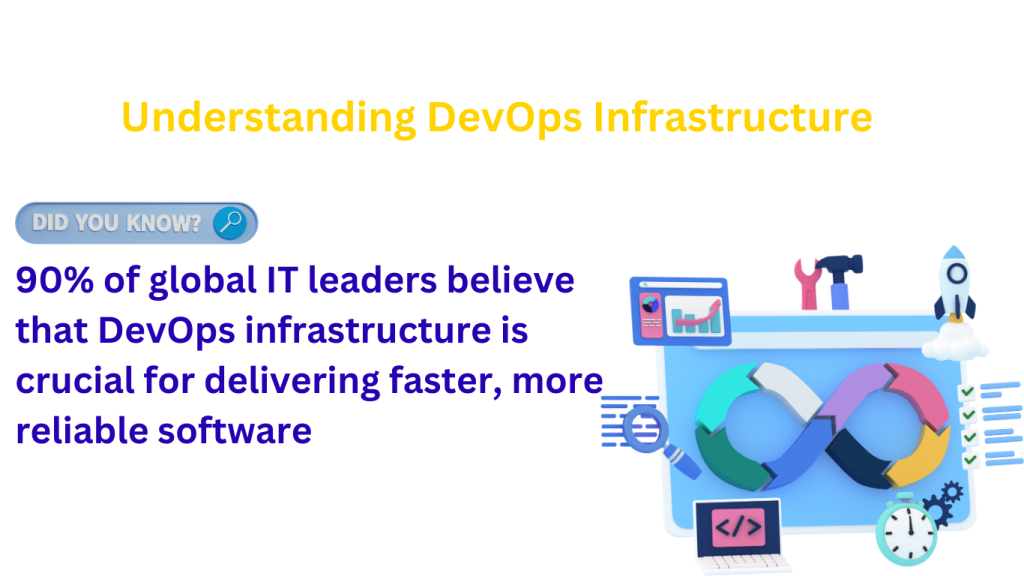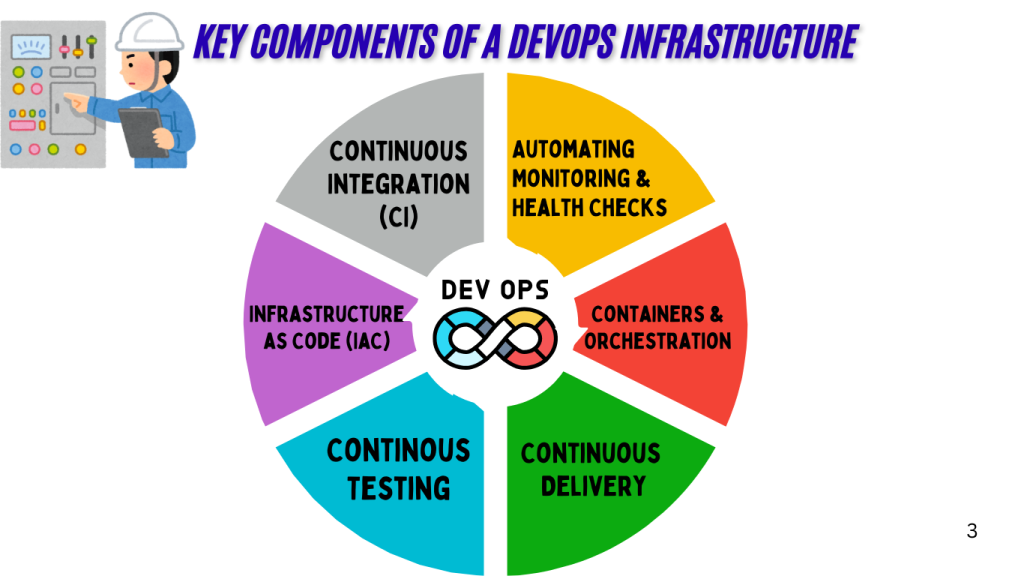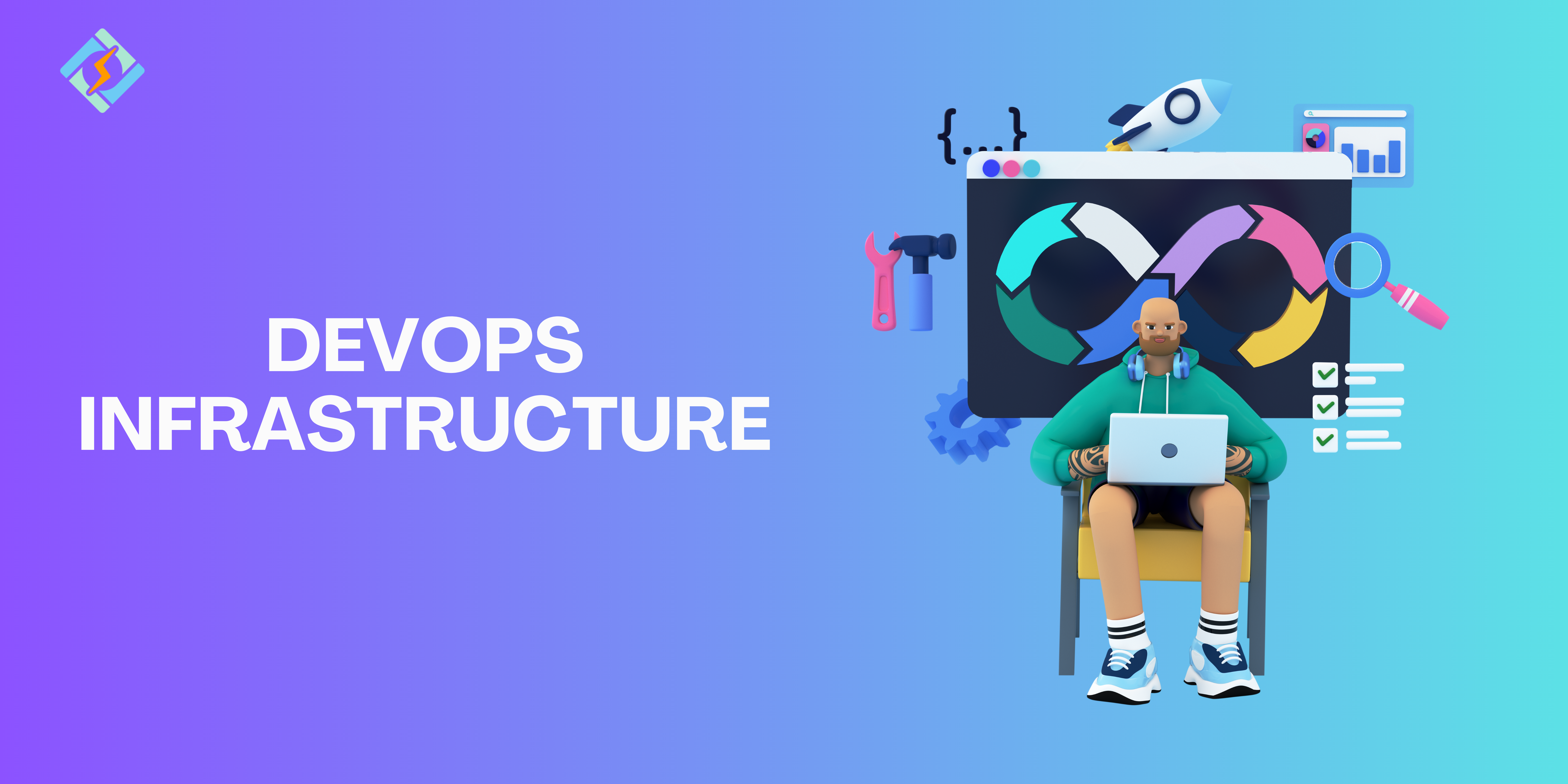DevOps Infrastructure is the heart of modern software development!
Those days of manually setting up servers and installing apps are long gone. In Today’s fast-paced digital era, DevOps infrastructure is key to building automated, effective, and scalable workflows. Infrastructure as code (IaC) and automation solutions allow companies to reduce human resources while ensuring consistent environments, faster deployments, and improved security.
Managing your infrastructure in the best possible ways is crucial since automating and streamlining your IT processes may significantly reduce your workload. Consider how you can scale Terraform might be used by a developing startup to easily manage its cloud infrastructure across development, staging, and production environments.
You can take the example of a big e-commerce site that uses Ansible to automate tedious deployment activities save a ton of time and guarantee error-free operations.
In this post, we’ll go over the advantages of implementing DevOps infrastructure, including Automation, Monitoring, and Infrastructure as Code (IaC), and we’ll demonstrate how to accomplish it.
You will have a plan by the end of the process for improving your own DevOps Infrastructure configuration and increasing the productivity of your company. Raise the bar for your development cycle with effective, practical solutions.
Get exclusive access to all things tech-savvy, and be the first to receive
the latest updates directly in your inbox.
So What is it exactly, and how can it help your team?
What is A DevOps Infrastructure?

DevOps infrastructure, also known as Infrastructure Automation within DevOps, is a concept that centers on the idea of using code to manage infrastructure. This happens with the support of specific programs or technologies that enable the activities to be completed automatically!
The DevOps teams can test the applications at a very early stage of the development cycle because the infrastructure is automated. This makes it possible to provide several testing environments and helps prevent common deployment-related problems.
Because DevOps’ major goal is to provide value by producing better software quickly that users can use right away without any issues. It minimizes resistance between the software architecture, the underlying infrastructure, and engineering code releases.
DevOps focuses on removing barriers and conflicts and shifting blame to development teams, operations, management, and stakeholders.
What are The Key Components of a Solid DevOps Infrastructure?
What makes a DevOps Infrastructure super solid for IT teams? Well, the infrastructure is built on many components, and each plays a crucial role in maintaining an efficient development process.

Let’s take a look at the following aspects:
1. Continuous Integration (CI): This ensures that developers can work on various features without encountering conflicts by automating the testing and merging of code changes. By automating the integration and testing of code changes, continuous integration ensures that software is of high quality and meets the needs of its users and stakeholders.
2. Continuous Delivery, or CD, makes it easier for code to be automatically sent to production environments, allowing for quicker releases.
3. Containers & Orchestration: It is possible to package and deploy apps in isolated environments with efficiency by using tools like Docker and Kubernetes.

4. Infrastructure as Code (IaC): IaC in DevOps makes it possible to install and maintain infrastructure in a scalable and repeatable manner. allows it to be simpler to manage, replicate, and scale environments by automating the setup and configuration of infrastructure using code. Which eventually reduces human error, automates deployment, and permits version control by specifying infrastructure as code.
Some popular Infrastructure as Code (IaC) tools: are Terraform, Ansible, Chef, Puppet, etc.
5. Automating Monitoring & Health Checks: Maintaining DevOps infrastructure health and application performance in DevOps requires automated monitoring and health checks.
Popular Tools Teams use Kibana, Nagios, and Prometheus to enhance performance, identify any problems early, and continuously monitor system behavior.
Now, majorly Automated monitoring identifies issues with servers, databases, and networks before they impact users, improving reliability and reducing downtime while ensuring seamless application operation.
6. Continous Testing: Continuous testing is an essential DevOps practice that ensures software is automatically and consistently tested during development. Updates can be made faster, better, and more reliable by teams identifying and resolving problems early on through the automation of tests including unit, integration, and performance. This ensures software satisfies stakeholder and user needs while reducing downtime and interruptions.
Popular testing tools for continuous testing: Jenkins, Selenium, and Puppet facilitate quick feedback and effective problem-solving.
Why DevOps Infrastructure as Code is a Game Changer?
DevOps Infrastructure as Code is truly a game changer when it comes to automation. It completely transformed how infrastructure is managed and deployed, especially today. Creating or making a huge shift possible from traditional ways of managing servers, networks, and databases to replacing this with automation, IaC very efficiently removes human mistakes and produces infrastructure configurations that are repeatable and version-controlled.
With IaC everything is automated! You don’t have to spend long hours writing code to deploy a server, you can do the same task with just a few lines of code. guaranteeing consistency every time. In fast-paced DevOps situations, where accuracy and speed are critical for ongoing deployment and updates, this is very useful.
DevOps Infrastructure as Code (IaC) streamlines scalability. Whether for a small website or a large enterprise, you can easily adjust resources by modifying the code. This efficiency allows teams to focus on innovation instead of setup details.
So you’re getting two major benefits out of this Faster Deployment & Scalibility. But there are other many benefits of DevOps infrastructure as code :
- Reliable and Consistent Configurations: IaC ensures uniform infrastructure setups across all environments, preventing issues like “it works on my machine” and minimizing the risk of configurations drifting out of sync.
- Increased Efficiency: IaC automates infrastructure management, saving time and allowing teams to focus on development and innovation.
- Version Control and Auditing: Changes are tracked in a version control system, allowing easy monitoring of who made modifications and providing an audit trail.
- Disaster Recovery and Rollbacks: In the event of failure, IaC enables a quick rollback to the last stable state, making recovery easier.
- Cost Management: Infrastructure as Code (IaC) helps reduce costs by creating temporary environments for specific tasks that can be easily de-provisioned when no longer needed..
In short, With DevOps Infrastructure as Code, DevOps teams can quickly create cloud settings for application testing and trial by managing, provisioning, and configuring an IT environment using code rather than manual configuration.
Best Tools for Managing & Automating Your DevOps Infrastructure
You can make use of the following tools to manage your DevOps Infrastructure automation:
- Terraform
Terraform uses infrastructure as code (IaC) to automate infrastructure across several cloud platforms, including AWS, Google Cloud, and Azure. It makes multi-cloud management easier and guarantees consistency. - Ansible
Ansible is an open-source agentless tool for automation and configuration management. Repetitive activities are streamlined, resulting in a quick and error-free infrastructure setup. - The Pulumi
Python and JavaScript are among the programming languages that Pulumi employs for IaC. On all of the main cloud platforms, it enables developers to more effectively deploy cloud resources. - CloudFormation on AWS
Utilizing templates, AWS CloudFormation automates the creation of AWS resources, guaranteeing consistent, repeatable settings for faster, error-free deployments.
Challenges in DevOps Infrastructure & How to Overcome Them in 2024
1. Reorienting their attention to better methods rather than tools
By concentrating more on methods, companies may concentrate more on strategies, which will allow them to select the best tools for any task. According to DevOps, adopting this strategy will help teams become accustomed to looking at the big picture before beginning any project and guarantee that the staff members working on it have access to the appropriate tools from the beginning.
2. Emphasizing the Proper Environment
Creating a strong team culture in a DevOps infrastructure is a challenge! Because having the appropriate mindset for the task is more important than simply employing the right tools. Projects can stall if thorough testing and optimization of infrastructure automation are not prioritized. Everyone must stay aligned on goals and progress, making team cohesion essential. A cooperative and adaptable culture ensures better outcomes and smoother transitions.
3. Excessive Use of Tools
putting too much focus on tools in the hopes that they can solve problems quickly is one of the biggest mistakes DevOps teams can make. Although tools may appear like a quick fix, they are not a replacement for sound processes or a cohesive team. It’s critical to have clear processes and strategies in place before implementing new technologies. In addition to being distracting from the task at hand, using too many tools without a clear approach can make things more complicated rather than simpler.
4. DevOps Infrastructure automation at every level of the infrastructure:
Reduces repetitive work, which increases productivity, but it has drawbacks. It takes trial and error to get the hang of automating chores, and system upgrades are necessary to prevent mistakes. To keep things running well, you must continuously monitor and optimize your automated process. Even though automation can greatly reduce developers’ time, it also requires constant work to make sure it runs well and doesn’t cause any new problems.
How to Implement DevOps Infrastructure in Your Organization
A systematic approach that emphasizes well-defined goals, team organization, and the incorporation of automation technologies for continuous integration and deployment is necessary for the successful implementation of DevOps. This is a concise explanation:
1. Starting the Project: To secure the required resources and match the DevOps strategy with business objectives, start with strong leadership support, such as that of the CIO.
2. Establish Specific Goals: Establish clear goals for both software delivery and operational effectiveness. To monitor progress and promote enhancements, use quantifiable KPIs.
3. Make a Complete Plan: Make a plan that promotes cooperation between the testing, operations, and development teams. Integrate Infrastructure as Code for effective provisioning and concentrate on accelerating the software development cycle without sacrificing quality. Use Tools like Terraform.
4. Create a Diverse DevOps Team: Bring together individuals from quality assurance, operations, and development. State roles and duties to encourage responsibility and cooperation.
5. Employ containerization: To make programs more dependable and simpler to deploy across different environments, use tools such as Docker.
6. Integrate Infrastructure and CI/CD Tools: For effective configuration management and streamlined deployments, combine CI/CD tools (like Jenkins) with infrastructure automation technologies (like Kubernetes).
7. Automate Testing: To increase turnaround time and enhance coverage, find the ideal blend between automated and manual testing. Make sure the development and QA teams collaborate closely to identify problems early preferably before the start of the software development phase to prevent any delays.
8. Continuously Performance Monitoring: Use monitoring tools to track system bottlenecks, user experiences, and application performance. This aids in quickly prioritizing fixes and optimizations.
Best Practices Tips!
- Start Small: Before expanding, start with pilot efforts.
- Make Training a Priority: Invest in educating your teams about the new procedures and tools.
- Repeat and Improve: Promote an environment that is always getting better.
Future of DevOps Infrastructure: Trends to Watch!
DevOps infrastructure evolves with the tech landscape. The following are a few trends to look out for:
Machine learning (ML) and artificial intelligence (AI): Increasingly, AI/ML technologies are being integrated to improve software development and delivery automation, efficiency, and responsiveness.
DevOps: a focus on integrating security measures at the outset of the development process to guarantee secure and reliable apps.
Serverless Computing: Serverless architectures, which let developers concentrate on writing code rather than managing servers, are becoming more and more popular.
Microservices with Containerization: continued development of adaptable, scalable, and deployable applications through the usage of microservices and containers.
Technologies for Collaboration: improved cooperation between the security, operations, and development teams to expedite processes and promote a shared responsibility culture.
Continuous Everything: To speed up software delivery and enhance quality, concentrate on continuous integration, continuous delivery (CI/CD), and continuous testing.
Conclusion
The foundation of every effective DevOps practice is DevOps infrastructure. Development teams can use tools, automation, and techniques like Infrastructure as Code to increase productivity, expand more quickly, and produce software of the highest quality.
To succeed in the long run, DevOps infrastructure must be adopted, especially through automation and Infrastructure as Code. Businesses may improve productivity, expedite development processes, and keep a competitive advantage in the fast-paced technological marketplace of today by utilizing state-of-the-art tools, creating a collaborative culture, and staying updated on developing trends. Adopt these procedures to make sure your group is prepared for the upcoming changes and challenges!
FAQ’s
1. What is DevOps infrastructure?
The term “DevOps infrastructure” describes the procedures, methods, and instruments that facilitate cooperation between the development and operations teams in order to produce software effectively and consistently.
2. How does software delivery get better with DevOps?
Through process automation, teamwork, and the integration of continuous integration and continuous deployment (CI/CD) techniques, DevOps improves software delivery, leading to quicker and more dependable releases.
3. In what ways can DevOps Infrastructure as Code (IaC) offer advantages?
IaC simplifies infrastructure administration by offering advantages including version control, automated provisioning, scalability, consistency in configurations, and simpler disaster recovery.
4. Which tools are the best tools to manage my DevOps infrastructure?
Terraform for IaC, Jenkins for CI/CD, Docker for containerization, and monitoring tools like Prometheus and Grafana are all crucial components for managing DevOps infrastructure.
5. How does automation fit into the infrastructure of DevOps?
In DevOps infrastructure automation is essential because it minimizes manual labor, expedites deployment procedures, guarantees consistency, and improves dependability throughout the development lifecycle.
6. In DevOps, how do CI/CD pipelines work?
From code integration to testing and deployment, CI/CD pipelines simplify the software development process, facilitating rapid feedback and enabling teams to release code more regularly and consistently.



